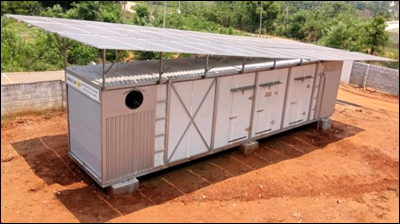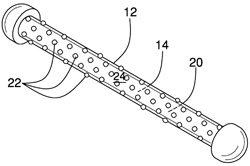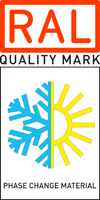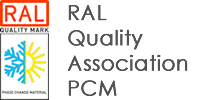AGRICULTURE

Solar cold storage keeps variety of produce at right temperatures
A solar-powered cold storage unit developed by Inficold of Hapur, India, can store fruits and vegetables at three different temperature ranges. The PCM-equipped unit provides uninterrupted cooling in rural locations where electrical power is not available or not reliable. The units are installed by farm cooperatives, private farmers, agriculture processing companies and government bodies. Nitin Goel, co-founder at Inficold, answered questions about the product by email:
Q: What are the dimensions of the unit?
A: “The 10 metric-ton solar cold storage with three chamber configurations comes in both containerized and non-containerized configuration. The containerized configuration has an external dimension of 40 x 8 x 9 feet. The internal volume 1500 cubic feet, which is divided across three chambers. Each chamber has its own independent temperature control.”
 Q: What temperature range is targeted in each of the three chambers?
Q: What temperature range is targeted in each of the three chambers?
A: “Each chamber can be independently controlled or set in the range of 1 to 12C. For example, we can have 1 to 2, 4 to 5 and 6 to 9 C in three chambers. We can also have 1 to 2, 1 to 2 and 7 to 12 C. Typically the temperature range set by end user is 1 to 3C, 5 to 7C and 10 to 12C. Both lower and upper temperature values of the setpoint are also configurable with 1 C graduation. Cooling is transfered to the chambers via pumps. When the temperature reaches a setpoint, the cooling stops.”
Q: What kind of produce is typically chilled in each chamber?
A: “These solar cold storages are used for short term storage applications of fruits, vegetables, flowers, fresh meat, fish, ripening etc and long-term storage applications of pulses, seed potato, dry grapes, dry chili etc. Few of the units are used for storing vaccines and medicines.”
Q: Is the unit connected to the grid? Diesel generator? Both?
A: “90 percent of the installations are in completely off-grid locations. The systems have one of the highest thermal energy storage capacity, solar panel capacity, and solar to cooling conversion efficiencies compared to the competitive solutions available in India. The solar cold storage comes with auto changeover feature to electric grid in case of prolonged cloudy season. The solar panel and thermal energy storage capacity is optimally sized based on the end user needs and to eliminate diesel generators.”
Q: How long can the chambers maintain their target temperatures without external power?
A: “A standard 10 metric-ton cold storage has 400 megajoules of thermal energy storage, which can precool 1000 kilograms of fresh produce from 35º to 4º C and maintain the cold storage temperature for 24 hours without the need of external power. In case, there is no precooling requirement, the same system can maintain the target temperature for up to four days without the need of external power and assuming thermal energy storage is fully charged.”
Q: What type of PCM is used in each chamber?
A: “The company uses proprietary in-house developed salt hydrate based phase change materials. The peak melting point is -4º C and heat storage capacity is 295 joules per gram. Thermal energy storage transfer cooling to the chambers through active cooling via pumps. When temperature reaches a setpoint, the cooling stops.”
Q: How many of these units have been produced, and how many does Inficold expect to sell this year?
A: “The company has deployed over 75+ solar cold storage units with the size ranging between 5 to 50 metric ton. Most of the installations are in India and few in Africa. We expect to sell 200+ units this year. The company has launched a solar refrigeration kit, which has refrigeration, thermal storage and control panels on a single skid. It allows the seamless integration by solar installer and cooling solution providers for applications in cold storage, milk cooler and air conditioning.”
Q: What kind of feedback are you getting from farmers?
A: “All of the solar cold storage installation done by Inficold are currently operational. The company has service teams in the north, south, central and northeast regions of India. The primary feedback received from the end user is higher built quality, capabilities to work during cloudy conditions, and tight temperature control. Inficold has conducted impact assessment of few installations.
“A 35-megaton solar cold storage installed in Uttarakhand has reduced wastages of organic pulses from 15% to 2% for all women farmer producer organizations. A 5-megaton solar cold storage installed in Uttar Pradesh has demonstrated banana ripening with doubling the annual income of farmer families. A solar instant milk chiller installed at a leading milk cooperative of Assam has reduced milk cooling expenditure by 50% and impacted more than 698 farmers.”
Q: What is the most interesting aspect of this technology, in your view?
A: “The interesting aspect of technology is scalability and adaptability to a wider set of applications. The same thermal energy storage technology is currently deployed on a commercial scale by Inficold for cold storage, milk coolers and air conditioners. The top three largest solar cold storages based on thermal energy storage in India are designed and installed by Inficold. Inficold have also integrated solar energy with thermal energy storage on existing cold storages, which got defunct due to high operational cost of electricity and diesel. A leading state government of India has been operating an Inficold 5-megaton solar cold storage based on thermal energy storage to keep vaccines at a hospital – the first and only such kind of installation in India.
“The company vision is to scale this thermal energy storage technology for bigger applications. The company is in commercial discussion to install 100 – 200 megaton-size off-grid solar cold storage based on thermal energy storage, which will be the largest ever installation in the world. The company has kick-started field testing of solar cold storage for onions and garlic, which require the control of both temperature and humidity.”
PATENTS
Switchable PCM systems for building envelopes
U.S. patent application 20220127843 (applicant Regents of the University of Colorado, Denver):
“In some aspects, the present disclosure relates to switchable phase change material system (SPCMS). In some embodiments, dynamic, switchable phase change material systems allow building envelope assemblies to store energy from one side and release to the other side in order to reduce thermal loads and peak demands for both space heating and cooling. PCM layers can be coupled with thermal insulation layers to ensure heat does not transfer readily through the building envelope and thus increase thermal heating and cooling loads for the building. In some embodiments of the present disclosure, a combination of rotatable members comprised of PCM and insulation are switchable in position such that layers with PCM are switched from one side to the other without the need to maintain the thermal insulation within a building envelope.”
Canine teething device
U.S. patent application 20220095584 (applicant Alex Warren, Mesa, Arizona):

“A canine teething device for alleviating teething pain in a puppy includes a shell, which defines an interior space and which is flexible or semiflexible. A phase change material is positioned in the shell and substantially occupies the interior space. The phase change material can be frozen in a freezer and the shell provided to a dog to be chewed upon. The phase change material absorbs heat from a mouth of the dog to provide relief of teething pain.”
PCM compositions and methods for their use to lower friction and wear
U.S. patent application 20220127540 (applicant Texas A&M University System, College Station, Texas):
“Phase change material compositions and methods for using the compositions to prepare substrate coatings or bulk blended polymers that advantageously lower friction between interacting substrate surfaces and lower substrate surface wear.”
More U.S. patent applications:
Compositions and methods for thermal management of textiles and foams (Alexium Inc., Greer, S.C.) | ThermaSat solar thermal propulsion system (Howe Industries LLC, Scottsdale, Ariz.) | Cooling of a laser set (Terry Dubois, et al, Forest Hill, Maryland) | Article of apparel (Under Armour Inc., Baltimore, Maryland) | Charging port cooling with PCM and porous heat conductor cage (GM Global Technology Operations, Detroit, Mich.) | Battery pack (Black & Decker Inc., New Britain, Conn.)
IN BRIEF
• A new trade association has been formed to promote the use of thermal storage in buildings in the United Kingdom. Thermal Storage UK, launched in March, has three founding members: heat battery makers Sunamp Ltd., Caldera and Tepeo. Said Sunamp CEO Andrew Bissel: “We expect the UK government to respond by working with us towards a strong policy framework for the technology helping set global standards. Thermal storage for hot water, space heating and cooling is a key element for decarbonising buildings in the UK and around the globe.”
 • 200 portable incubators are on their way to Ukraine, where they will be used to provide life-saving warmth to premature babies born in bomb shelters and hospitals. The Embrace incubators use phase change material to keep babies at 37º Celsius for up to eight hours without the need for a constant source of electricity. Embrace Global also has launched a GoFundMe campaign to help raise another $600,000 to send 3,000 incubators to Ukraine.
• 200 portable incubators are on their way to Ukraine, where they will be used to provide life-saving warmth to premature babies born in bomb shelters and hospitals. The Embrace incubators use phase change material to keep babies at 37º Celsius for up to eight hours without the need for a constant source of electricity. Embrace Global also has launched a GoFundMe campaign to help raise another $600,000 to send 3,000 incubators to Ukraine.
• Engineers at MIT and the National Renewable Energy Laboratory have developed a heat engine with no moving parts that can convert heat to electricity with over 40 percent efficiency – a performance better than that of traditional steam turbines.
• Researchers at the University of Illinois Chicago have developed a longer-lasting alternative to conventional aircraft deicers. The PCM-based gel coatings “can delay formation of frost for extended hours and simultaneously cause any ice formed on its surface to easily shed off by a gentle breeze or simple substrate tilting,” said Ph.D. student Rukmava Chatterjee.
• Yotta Energy of Austin, Texas, has raised an additional $3.5 million, including a strategic investment from inverter OEM partner APsystems. Yotta’s SolarLeaf, a 1-kWh lithium-iron phosphate battery designed to be paired with rooftop solar panels, is equipped with phase change material to manage excess heat.
• Members of the RAL Quality Association PCM have agreed to hold their next general assembly on Oct. 11 in Brussels, Belgium. It will be the organization’s first in-person meeting since 2019.
• Va-Q-tec is expanding its range of low-temperature and cryogenic transport solutions with the new transport boxes va-Q-proof for -70 °C shipments and va-Q-genic for -150 °C shipments. The company, based in Wurzburg, Germany, says va-Q-proof requires significantly less dry ice than competing products.
• Phase Change Solutions Inc. of Greensboro, N.C., has an opening for an environmental, health and safety manager to oversee the company’s compliance with local, state and federal environmental, health and safety regulations.
• The Institute for Technical Thermodynamics of the German Aerospace Center (DLR) is seeking applicants to lead its thermal systems with phase change group.
RESEARCH ROUNDUP
From Energies:
From ACS Omega:
• Phase Change Material with Gelation Imparting Shape Stability
From Applied Thermal Engineering:
From Journal of Building Engineering:
• Energy saving in buildings by using the exhaust air and phase change material for cooling of photovoltaic panels
• Evaluation of building integrated with phase change material considering of ASHRAE classification using seasonal and annual analysis
From Construction and Building Materials:
• Proposed specific heat capacity model for a concrete wall containing phase change material (PCM) under field experiment conditions
• Thermal behavior evaluation of a radiant floor heating system incorporates a microencapsulated phase change material
From Journal of Energy Storage:
• Experimental and numerical thermal analysis of a lithium-ion battery module based on a novel liquid cooling plate embedded with phase change material
• Evaluation of the energy storage capacity of Phase Change Material cement-lime mortars by using heat flux meters and ultrasonic pulse transmission
• Simulation of melting and solidification processes of organic phase change materials used in storing heat energy in multi-layers heat exchanger
• Phase change material based thermal management of lithium ion batteries: A review on thermal performance of various thermal conductivity enhancers
• Thermal analysis and assessment of phase change material utilization for heating applications in buildings: A modelling
• Year-long energy analysis of building brick filled with phase change materials
• Developments in phase change material (PCM) doped energy efficient polyurethane (PU) foam for perishable food cold-storage applications: A review
From Sustainable Energy Technologies and Assessments:
From Chemical Engineering Journal:
From Energy and Fuels:
From Solar Energy Materials and Solar Cells:
From Energy:
From Forests:
• Bio-Based Phase Change Materials for Wooden Building Applications
From Materials Today: Proceedings:
• Study of eutectic organic phase change materials with enhanced thermal properties
• Use of agglomerated Micro-encapsulated phase change material in cement mortar as thermal energy storage material for buildings
From Journal of Thermal Analysis:
From Environmental Science and Pollution Research:
From Smart Energy:
From Solar Energy:
From New Journal of Chemistry:
NETWORKING
Connect with PCM experts and industry leaders on LinkedIn
 More than 1,700 people have joined a LinkedIn group devoted to the discussion of phase change material and thermal energy storage. You are invited to join the Phase Change Matters group and connect with PCM and TES experts from around the world.
More than 1,700 people have joined a LinkedIn group devoted to the discussion of phase change material and thermal energy storage. You are invited to join the Phase Change Matters group and connect with PCM and TES experts from around the world.
This month we welcome Catherine Lee, business development manager at Bondller Materials Inc., Shenzhen, China; Shaji Sidney, research and development engineer at Tan90, Chennai, India; Greg Newcomer, president at Vereco Energy Systems LLC, Moorestown, N.J.; Nusrat Jahan Joana, customer relationship officer at Ghorami Technology, Dhaka, Bangladesh; Neha Sharma, senior research fellow at Defense Institute of Bio-Energy Research, Haldwani, India; and Shivaji Kale, assistant professor of mechanical engineering at K.K. Wagh institute of Engineering Education and Research, Nashik, India.
NEWS TIPS
Does your company, agency or university have a job opening, new research, new product or other news you’d like to share? I would love to hear from you. Please contact newsletter editor Ben Welter at benedict.welter@gmail.com.
A WORD FROM OUR SPONSOR
 This newsletter is made possible through the generous support of the RAL Quality Association PCM and the members listed below. To learn more about the association, including membership benefits, please contact Stefan Thomann, executive director, at pcm@kellencompany.com.
This newsletter is made possible through the generous support of the RAL Quality Association PCM and the members listed below. To learn more about the association, including membership benefits, please contact Stefan Thomann, executive director, at pcm@kellencompany.com.
Axiotherm GmbH | Croda Europe Ltd. | ISU Chemical Co. Ltd. | Microtek Laboratories | PCM Technology | PLUSS Advanced Technologies | PureTemp LLC | Rubitherm Technologies GmbH | RuhrTech | Sasol Germany GmbH | S.Lab Asia Inc. | Sunamp Ltd. | va-Q-tec AG
MEMBER SPOTLIGHT: Ruhr New Material Technology Co. Ltd. | Hangzhou, China

RuhrTech specializes on PCM-based products for passive cooling in cold chains and is the reliable partner of pharmaceutical companies, clinical research organizations and logistics. We provide a national rental service for our cold packages with five central warehouses and 42 stores throughout China. We also offer PCM-based heat sink films and colloids for the temperature management of electrical devices. For information on the latest PCM developments for pharma logistics and cold chains, and for PCM films and colloids, please contact RuhrTech.
